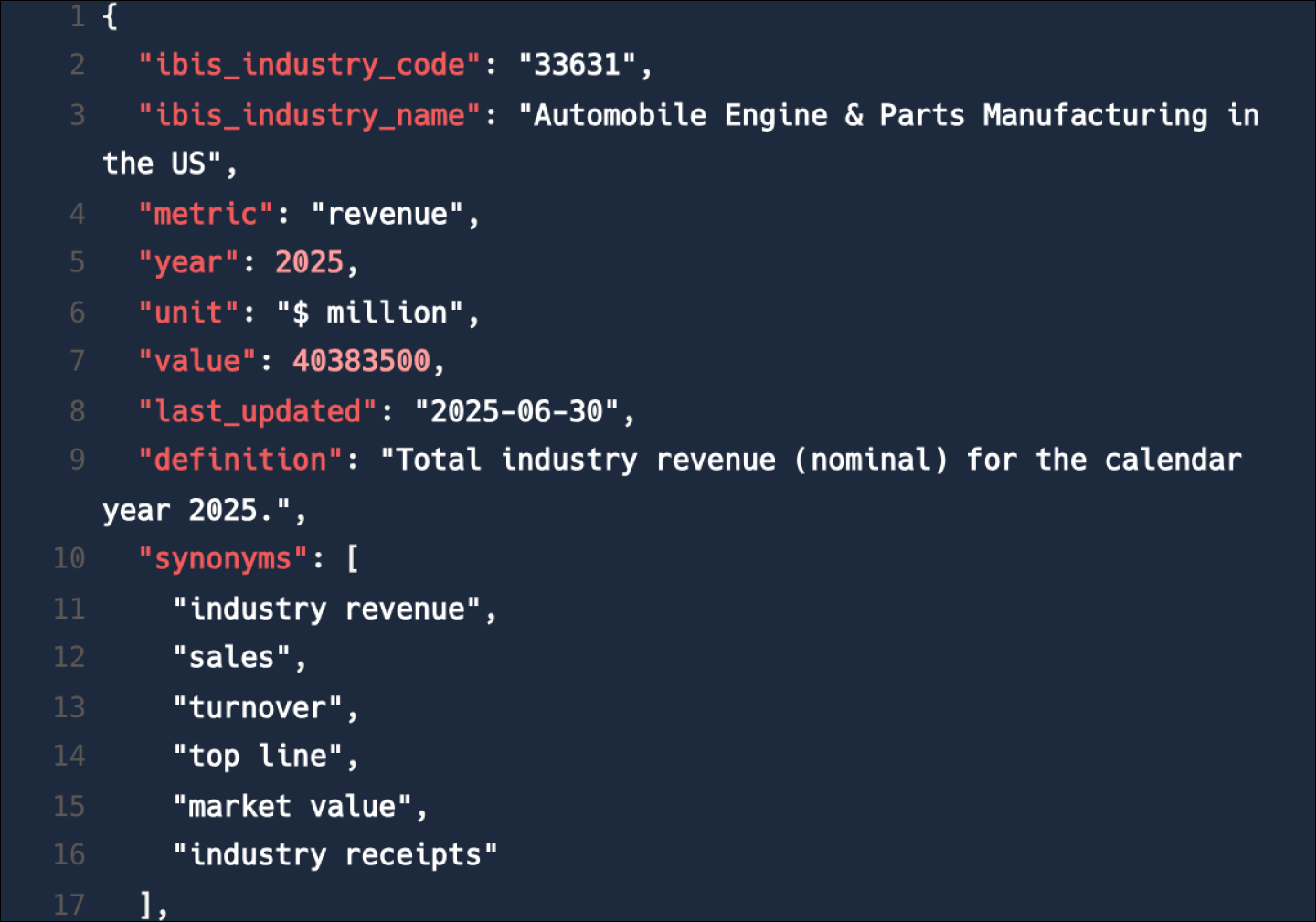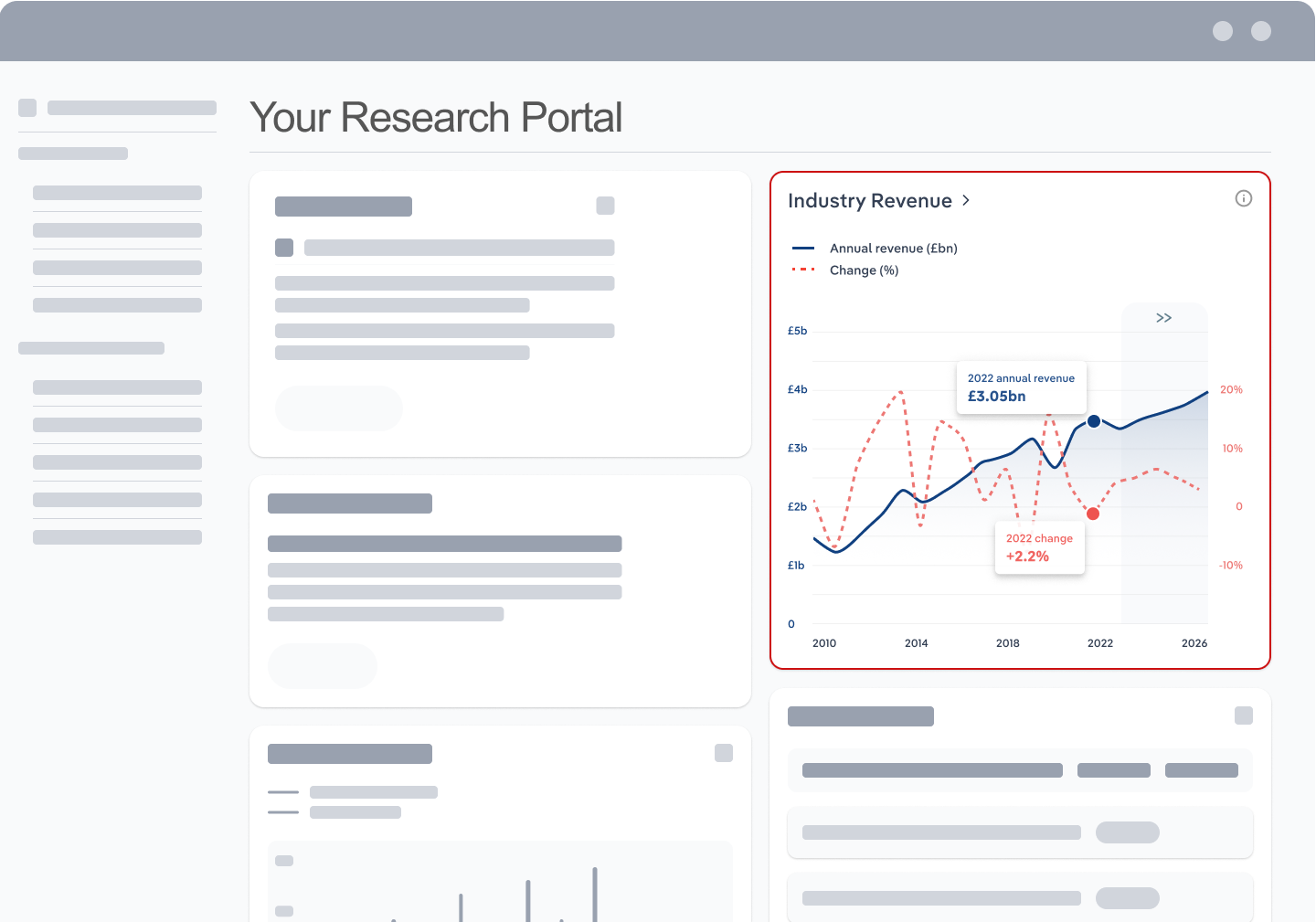Industry Statistics and Trends
Market size and recent performance (2015-2030)
Industry revenue has declined at a CAGR of 2.7 % over the past five years, to reach an estimated $300.2m in 2025.
Trends and Insights
A tumultuous market hampered demand early
- According to ABS data, photographic and optical goods manufacturing exhibited a tough trading environment over the two years through 2021-22, with revenue falling by 8.4% in current terms. The outbreak of COVID-19 at the start of the period brought about trading restrictions and lockdown periods, which heavily dented revenue and performance.
- Additional trends and insights available with purchase
Industry outlook (2025-2030)
Market size is projected to grow over the next five years.
Trends and Insights
An upswing in trading conditions will support revenue
- Trading conditions are set to improve for photographic and optical goods manufacturers, fuelled to a large extent by an upswing in demand from optometrists and ophthalmologists, the industry's largest downstream market. Australia's aging population will propel optometry care for long-term eye conditions. Greater use of personal computers and other electric devices and a continued focus on maintaining good eye health will drive demand for ongoing testing across the wider community.
Biggest companies in the Photographic and Optical Goods Manufacturing in Australia
| Company | Market Share (%)
2025 | Revenue ($m)
2025 |
|---|---|---|
Lumibird Medical Australia | 32.5 | |
Redflex Holdings | 25.0 | |
Gelflex Laboratories | 14.0 |
To view the market share and analysis for all 4 top companies in this industry, view purchase options.
Products & Services Segmentation
Industry revenue is measured across several distinct product and services lines, including Glass and contact lenses, glasses frames and sunglasses, Microscopes, telescopes, binoculars and parts and Cameras, projectors, and parts. Glass and contact lenses, glasses frames and sunglasses is the largest segment of the Photographic and Optical Goods Manufacturing in Australia.
Trends and Insights
Imports competition affects demand for glass and contact lenses, glass frames and sunglasses
- Photographic and optical goods manufacturers produce spectacles, contact lenses, glasses frames and sunglasses, partnering with optical laboratories for lens prescription services. While the vast majority of companies operating in the industry are foreign-owned, Perth-based, Gelflex Laboratories - founded in 1971 - remains Australian-owned and operated.
- More insights available in the full report
Table of Contents
About this industry
Industry definition
Industry firms manufacture photographic equipment and optical instruments and equipment. The industry also includes optical lens grinders and manufacturers of ophthalmic goods such as contact lenses, sunglasses, spectacle frames and sunglass frames.
What's included in this industry?
Products and services covered in the Photographic and Optical Goods Manufacturing industry in Australia include Microscopes, telescopes, binoculars and parts, Glass and contact lenses, glasses frames and sunglasses, Cameras, projectors, and parts and Ophthalmic instruments and appliances.Companies
Companies covered in the Photographic and Optical Goods Manufacturing industry in Australia include Lumibird Medical Australia, Redflex Holdings and Gelflex Laboratories.Purchase this report to view all 4 major companies in this industry.
Related Terms
Related terms covered in the Photographic and Optical Goods Manufacturing industry in Australia include glaucoma, lasik, orthokeratology and ophthalmic equipment.Industry Code
ANZSIC 2411 - Photographic and Optical Goods Manufacturing in Australia
Performance
Get an indication of the industry's health through historical, current and forward-looking trends in the performance indicators that make or break businesses.
Analyst insights
Import competition remains strong, with China at 31.4% of imports in 2023-24. Despite the high import share, new local businesses are emerging, driven by technological advanc...
In this chapter (4)
- Current Performance
- Outlook
- Volatility
- Life Cycle
Key metrics
- Annual Revenue, Recent Growth, Forecast, Revenue Volatility
- Number of Employees, Recent Growth, Forecast, Employees per Business, Revenue per Employee
- Number of Businesses, Recent Growth, Forecast, Employees per Business, Revenue per Business
- Total Profit, Profit Margin, Profit per Business
Charts
- Revenue, including historical (2015-2024) and forecast (2025-2030)
- Employees, including historical (2015-2024) and forecast (2025-2030)
- Businesses, including historical (2015-2024) and forecast (2025-2030)
- Profit, including historical (2015-2025)
- Industry Volatility vs. Revenue Growth
- Industry Life Cycle
Detailed analysis
- Trends in supply, demand and current events that are driving current industry performance
- Expected trends, economic factors and ongoing events that drive the industry's outlook
- Key success factors for businesses to overcome volatility
- How contribution to GDP, industry saturation, innovation, consolidation, and technology and systems influence the industry's life cycle phase.
Products and Markets
Learn about an industry's products and services, markets and trends in international trade.
Analyst insight
The demand for microscopes, telescopes, and binoculars is on the rise, driven by technological advancements and increased use in scientific research, defence, and healthcare. ...
In this chapter
- Products & Services
- Major Markets
- International Trade
Key metrics
- Largest market segment and value in 2025
- Product innovation level
- Total imports, level and trend
- Total exports, level and trend
- Trade Balance
Charts
- Products & services segmentation in 2025
- Major market segmentation in 2025
- International trade, including imports by country and exports by country
Detailed analysis
- Trends impacting the recent performance of the industry's various segments
- Innovations in the industry's product or service offering, specialization or delivery method
- Key factors that successful businesses consider in their offerings
- Buying segments and key trends influencing demand for industry products and services
- Recent trends in import and export volumes, country of origin or destination, and expected future trends
Geographic Breakdown
Discover where business activity is most concentrated in an industry and the factors driving these trends to find opportunities and conduct regional benchmarking.
Analyst insights
New South Wales, Victoria, and Queensland are the industry’s epicentre, accounting for over 70% of enterprises due to strategic access to transport hubs and ports. These stat...
In this chapter (1)
- Business Locations
Charts
- Share of revenue, establishment, wages and employment in each region
- Share of population compared to establishments in each region in 2025
Tables
- Number and share of establishments in each region in 2025
- Number and share of revenue each region accounts for in 2025
- Number and share of wages each region accounts for in 2025
- Number and share of employees in each region in 2025
Detailed analysis
- Geographic spread of the industry across Asia Pacific, and trends associated with changes in the business landscape
- Key success factors for businesses to use location to their advantage
Competitive Forces
Get data and insights on what's driving competition in an industry and the challenges industry operators and new entrants may face, with analysis built around Porter's Five Forces framework.
Analyst insights
Foreign competition is a major external factor facing Australia's Photographic and Optical Goods Industry. Due to high labour costs and a small domestic market, Australian fi...
In this chapter (4)
- Concentration
- Barriers to Entry
- Substitutes
- Buyer & Supplier Analysis
Key metrics
- Industry concentration level
- Industry competition level and trend
- Barriers to entry level and trend
- Substitutes level and trend
- Buyer power level and trend
- Supplier power level and trend
Charts
- Market share concentration among the top 4 suppliers from 2020-2025
- Supply chain including upstream supplying industries and downstream buying industries, flow chart
Detailed analysis
- Factors impacting the industry’s level of concentration, such as business distribution, new entrants, or merger and acquisition activity.
- Key success factors for businesses to manage the competitive environment of the industry.
- Challenges that potential industry entrants face such as legal, start-up costs, differentiation, labor/capital intensity and capital expenses.
- Key success factors for potential entrants to overcome barriers to entry.
- Competitive threats from potential substitutes for the industry’s own products and services.
- Key success factors for how successful businesses can compete with substitutes.
- Advantages that buyers have to keep favorable purchasing conditions.
- Advantages that suppliers have to maintain favorable selling conditions.
- Key success factors for how businesses can navigate buyer and supplier power.
Companies
Learn about the performance of the top companies in the industry.
Analyst insights
Australia's Photographic and Optical Goods Manufacturing industry is mostly populated by small-to-medium sized enterprises. These firms dominate the sector due to low-income ...
In this chapter
- Market Share Concentration
- Companies
- Company Spotlights
Charts
- Industry market share by company in 2021 through 2025
- Major companies in the industry, including market share, revenue, profit and profit margin in 2025
- Overview of Lumibird Medical Australia's performance by revenue, market share and profit margin from 2019 through 2025
- Overview of Redflex Holdings's performance by revenue, market share and profit margin from 2019 through 2025
- Overview of Gelflex Laboratories's performance by revenue, market share and profit margin from 2019 through 2025
- Overview of revenue, market share and profit margin trend for one additional company
Detailed analysis
- Description and key data for Lumibird Medical Australia, and factors influencing its performance in the industry
- Description and key data for Redflex Holdings, and factors influencing its performance in the industry
- Description and key data for Gelflex Laboratories, and factors influencing its performance in the industry
- Description, key data and performance trends for one additional company
External Environment
Understand the demographic, economic and regulatory factors that shape how businesses in an industry perform.
Analyst insights
Demand from optometry and optical dispensing significantly impacts ophthalmic goods sales. An increase in consumer demand for optometry services can lead to higher sales of g...
In this chapter
- External Drivers
- Regulation & Policy
- Assistance
Key metrics
- Regulation & policy level and trend
- Assistance level and trend
Charts
- Regulation & Policy historical data and forecast (2015-2030)
- Assistance historical data and forecast (2015-2030)
Detailed analysis
- Demographic and macroeconomic factors influencing the industry, including Regulation & Policy and Assistance
- Major types of regulations, regulatory bodies, industry standards or specific regulations impacting requirements for industry operators
- Key governmental and non-governmental groups or policies that may provide some relief for industry operators.
Financial Benchmarks
View average costs for industry operators and compare financial data against an industry's financial benchmarks over time.
Analyst insights
Rising operating costs have pressured industry profit margins. Despite recovering from pandemic-related demand drops, increased purchase and wage expenses have eroded profita...
In this chapter
- Cost Structure
- Financial Ratios
- Key Ratios
Key metrics
- Profit margin, and how it compares to the sector-wide margin
- Average wages, and how it compares to the sector-wide average wage
- Largest cost component as a percentage of revenue
- Industry average ratios for days' receivables, industry coverage and debt-to-net-worth ratio
Charts
- Average industry operating costs as a share of revenue, including purchases, wages, depreciation, utilities, rent, other costs and profit in 2025
- Average sector operating costs as a share of revenue, including purchases, wages, depreciation, utilities, rent, other costs and profit in 2025
- Investment vs. share of economy
Data tables
- Cash Flow & Debt Service Ratios (2015-2030)
- Revenue per Employee (2015-2030)
- Revenue per Enterprise (2015-2030)
- Employees per Establishment (2015-2030)
- Employees per Enterprise (2015-2030)
- Average Wage (2015-2030)
- Wages/Revenue (2015-2030)
- Establishments per Enterprise (2015-2030)
- IVA/Revenue (2015-2030)
- Imports/Demand (2015-2030)
- Exports/Revenue (2015-2030)
Detailed analysis
- Trends in the cost component for industry operators and their impact on industry costs and profitability
Key Statistics
Industry Data
Data Tables
Including values and annual change:
- Revenue (2015-2030)
- IVA (2015-2030)
- Establishments (2015-2030)
- Enterprises (2015-2030)
- Employment (2015-2030)
- Exports (2015-2030)
- Imports (2015-2030)
- Wages (2015-2030)
Top Questions Answered
Unlock comprehensive answers and precise data upon purchase. View purchase options.
What is the market size of the Photographic and Optical Goods Manufacturing industry in Australia in 2025?
The market size of the Photographic and Optical Goods Manufacturing industry in Australia is $300.2m in 2025.
How many businesses are there in the Photographic and Optical Goods Manufacturing industry in Australia in 2025?
There are 161 businesses in the Photographic and Optical Goods Manufacturing industry in Australia, which has grown at a CAGR of 4.1 % between 2020 and 2025.
How may import tariffs affect the Photographic and Optical Goods Manufacturing industry in Australia?
The Photographic and Optical Goods Manufacturing industry in Australia is likely to be significantly impacted by import tariffs with imports accounting for a high share of industry revenue.
How may export tariffs affect the Photographic and Optical Goods Manufacturing industry in Australia?
The Photographic and Optical Goods Manufacturing industry in Australia is likely to be significantly impacted by export tariffs with exports accounting for a high share of industry revenue.
Has the Photographic and Optical Goods Manufacturing industry in Australia grown or declined over the past 5 years?
The market size of the Photographic and Optical Goods Manufacturing industry in Australia has been declining at a CAGR of 2.7 % between 2020 and 2025.
What is the forecast growth of the Photographic and Optical Goods Manufacturing industry in Australia over the next 5 years?
Over the next five years, the Photographic and Optical Goods Manufacturing industry in Australia is expected to grow.
What are the biggest companies in the Photographic and Optical Goods Manufacturing industry in Australia?
The biggest companies operating in the Photographic and Optical Goods Manufacturing industry in Australia are Lumibird Medical Australia, Redflex Holdings and Gelflex Laboratories
What does the Photographic and Optical Goods Manufacturing industry in Australia include?
Microscopes, telescopes, binoculars and parts and Glass and contact lenses, glasses frames and sunglasses are part of the Photographic and Optical Goods Manufacturing industry in Australia.
Which companies have the highest market share in the Photographic and Optical Goods Manufacturing industry in Australia?
The company holding the most market share in the Photographic and Optical Goods Manufacturing industry in Australia is Lumibird Medical Australia.
How competitive is the Photographic and Optical Goods Manufacturing industry in Australia?
The level of competition is high and increasing in the Photographic and Optical Goods Manufacturing industry in Australia.
Methodology
How are IBISWorld reports created?
IBISWorld has been a leading provider of trusted industry research for over 50 years to the most successful companies worldwide. With offices in Australia, the United States, the United Kingdom, Germany and China, we are proud to have local teams of analysts that conduct research, data analysis and forecasting to produce data-driven industry reports.
Our analysts start with official, verified and publicly available sources of data to build the most accurate picture of each industry. Analysts then leverage their expertise and knowledge of the local markets to synthesize trends into digestible content for IBISWorld readers. Finally, each report is reviewed by one of IBISWorld’s editors, who provide quality assurance to ensure accuracy and readability.
IBISWorld relies on human-verified data and human-written analysis to compile each standard industry report. We do not use generative AI tools to write insights, although members can choose to leverage AI-based tools within the platform to generate additional analysis formats.
What data sources do IBISWorld analysts use?
Each industry report incorporates data and research from government databases, industry-specific sources, industry contacts, and our own proprietary database of statistics and analysis to provide balanced, independent and accurate insights.
Key data sources in Australia include:
- Australian Bureau of Statistics
- Australian Taxation Office
- Australian Securities & Investments Commission
Analysts also use industry specific sources to complement catch-all sources, although their perspective may focus on a particular organization or representative body, rather than a clear overview of all industry operations. However, when balanced against other perspectives, industry-specific sources provide insights into industry trends.
These sources include:
- Industry and trade associations
- Industry federations or regulators
- Major industry players annual or quarterly filings
Finally, IBISWorld’s global data scientists maintain a proprietary database of macroeconomic and demand drivers, which our analysts use to help inform industry data and trends. They also maintain a database of statistics and analysis on thousands of industries, which has been built over our more than 50-year history and offers comprehensive insights into long-term trends.
How does IBISWorld forecast its data?
IBISWorld’s analysts and data scientists use the sources above to create forecasts for our proprietary datasets and industry statistics. Depending on the dataset, they may use regression analysis, multivariate analysis, time-series analysis or exponential smoothing techniques to project future data for the industry or driver. Additionally, analysts will leverage their local knowledge of industry operating and regulatory conditions to impart their best judgment on the forecast model.
IBISWorld prides itself on being a trusted, independent source of data, with over 50 years of experience building and maintaining rich datasets and forecasting tools. We are proud to be the keystone source of industry information for thousands of companies across the world.
Learn more about our methodology and data sourcing on the Help Center.










